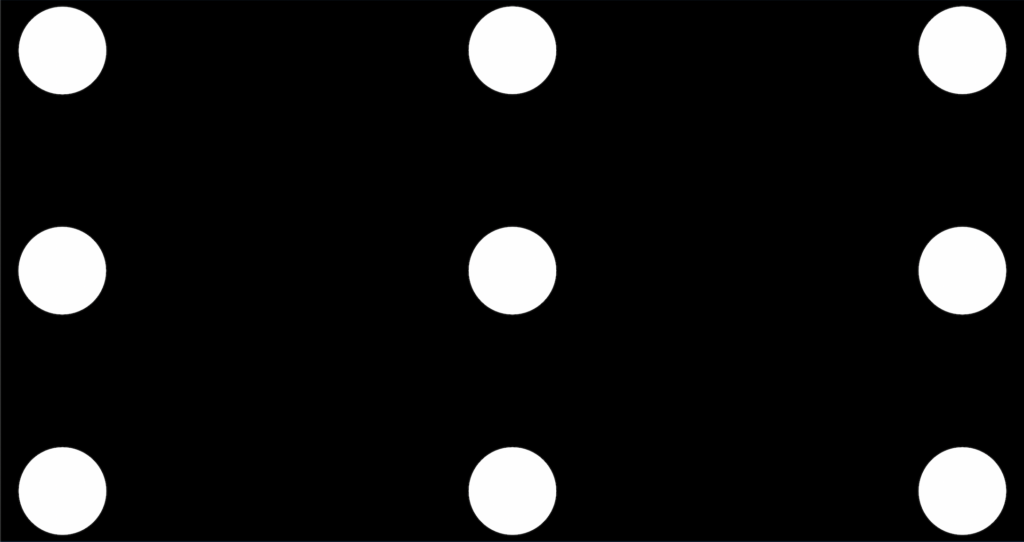This DCP is called 9Dice. It is a Flat image in a Full Container.
As always, the pass code for downloading is QA_b4_QC
Background
The image may seem similar to the proposed images from the SMPTE Luminance Study Group. In that group they decided to recommend that luminance measurements be taken from a constrained target instead of from a full screen of white. In tests, a full screen of white may give up to 10% errors in the measurements compared to taking from a constrained target due to lens glaring and flaring.
NATO made a project out of this as well, with significant testing in dozens of typical auditoriums as well as review facilities.
The Size of the targets
In fact, the targets on this slide were drawn such that the total number of pixels that are white are equal to 10% of the Flat size screen. This was decided upon because there are studies that show that the typical average luminance onscreen is 10% of the brightest levels. One 10% dot wouldn’t be an interesting test, and after many potential solutions, 9 distributed spots were created.
Flat being 3996 pixels by 2160 pixels, or 8631360 pixels, dividing that by 10 equals 863136 pixels for 10 percent luminance…if the screen were correctly saturated all the way around perhaps.
Divide that by 9, means that each dot is 95904 pixels.
Since pi*r2 is the correct formula for the Area of a circle, we can solve for ‘r’. We divide by pi to make the formula r2=Area/pi, and if the area is 95904, dividing by pi gives us 30527.2 for ‘r2‘. Getting the square root of 30527.2 gives us a radius of 174.7 pixels, and a diameter of just under 350 pixels (349.44).
Finally, a round number that even I can remember!
This DCP is 15 seconds long, with the idea that when you are testing you can Pause the projector. There are versions with targeting points in the circles, and 3D versions as well. If you would like such a thing, send an email to [email protected]
Do you want the Scope or Flat Version?
You want to use a Scope DCP if your screen is in native scope format, Flat for those screens that are natively in Flat format. That is, if the screen has to get smaller to make a Scope picture, then it is natively Flat. If the masking comes in to make the screen smaller for Flat movies, then it is a natively Scope screen.
And, for those who are really paying attention, both of these formats are actually in the Full Container size – which your projector should take care of.
Scope Version:
Finally, the nine 350 pixel circles are going to be varying sizes across the screen depending on the length of the throw from the projector lens to the screen. You can calculate that yourself, but here is a clue: Angular Size Calculator
Anything else? Like, where do we measure from?
OK, another finally. How far back do you want to be? A SMPTE report titled 20F Technology Committee On-Screen Light Measurement Study Group Report continued the recommendations of SMPTE Standard ST 196-M:
5 Luminance level
5.1 Measurement location
To simulate audience viewing, screen luminance measurements shall be taken from the center of the seating area at a height of approximately 1 m (39 in) above the floor. To ensure reasonable luminance at other seating locations, measurements shall also be taken from the center and each end of the middle row, and shall be within the limits given in 5.3 or 5.4.
5.2 Theater nominal luminance
Theater screen luminance shall be nominally 55 cd/m2 (16 fL) measured at the screen center. The luminance of the screen sides and corners shall be measured at a distance of 5% of the screen width from the screen edges. The readings shall be taken from each location specified in 5.1.
5.3 Theater luminance limits
Theater screen luminance at the screen center shall be between 41 cd/m2 (12 fL) and 75 cd/m2 (22 fL). Luminance at the screen sides shall be 75% to 90% of the screen center luminance, but not less than 34 cd/m2 (10 fL).
5.4 Review room luminance and limits
Review room screen luminance shall be 55 cd/m2 ± 7 cd/m2 (16 fL ± 2 fL) at the screen center. The luminance of the screen sides and corners, measured as described in 5.2, shall be at least 80% of the screen center reading.
6 Luminance distribution
The screen luminance shall be symmetrically distributed about the geometric center of the screen. The luminance of any point on the screen between the center and the edges, as measured from any seat in the middle row, shall not exceed the screen center reading (see annex A.2). For screens with a gain factor of 1.1 or more, the screen shall be curved for light uniformity as described in SMPTE RP 95. A more complete measurement of screen luminance distribution is described in SMPTE RP 98 and is recommended for new or revised installations.
Again, as always, the pass code is QA_b4_QC